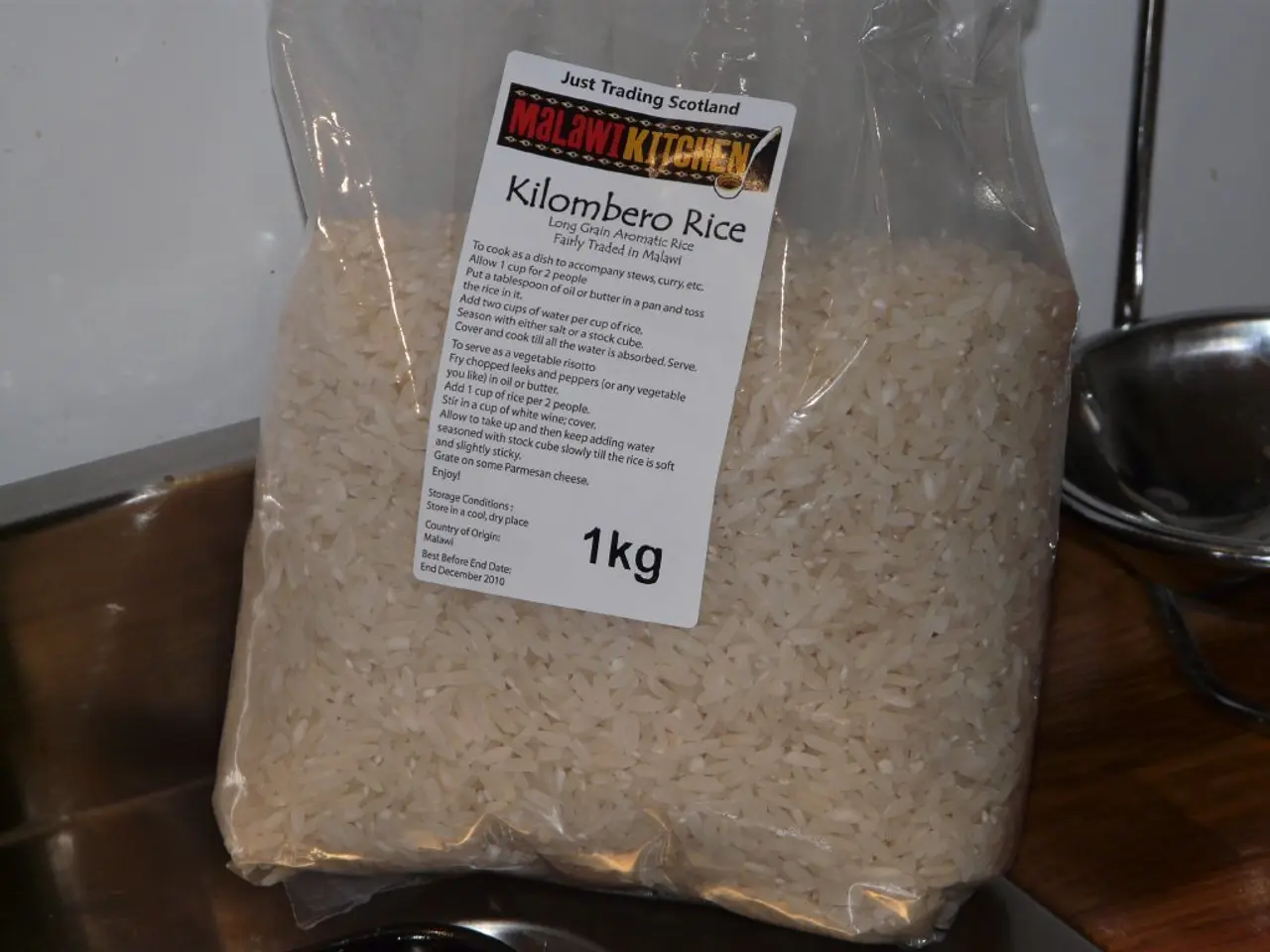Exploring the Health Benefits and Risks of Brown Jasmine Rice
Jasmine rice's nutritional profile and health implications
Brown jasmine rice, a popular variety of rice, offers several health benefits over its white counterpart. This is primarily due to the presence of bran and germ in brown rice, which are stripped away during the refining process of white rice.
Nutritional Advantages of Brown Jasmine Rice
Brown jasmine rice boasts a higher fibre content, which aids in lowering cholesterol, improving blood lipid profiles, and regulating blood pressure, thereby reducing the risk of cardiovascular disease (CVD) [1][2].
Additionally, brown rice has a lower glycemic index (around 55) compared to white rice (around 64), causing less rapid blood sugar spikes and thus lowering the risk of insulin resistance and type 2 diabetes by about 16% [4].
Moreover, brown rice contains more vitamins, minerals, antioxidants, and beneficial compounds with anti-inflammatory and cardioprotective properties, while white rice is stripped of many nutrients during processing [1][2][3].
Some studies also suggest antioxidant and antimutagenic properties in brown rice that may support reduced cancer risk, including breast cancer [3].
Potential Health Risks of Brown Jasmine Rice
Despite its benefits, brown jasmine rice poses a greater risk of arsenic exposure, a significant health concern. Arsenic accumulates in the outer layers of the rice grain, and because brown rice retains these layers, it generally contains higher levels of inorganic arsenic than white rice [1][3][5].
Exposure to arsenic is linked to various cancers, cardiovascular disease, diabetes, neurological problems, and developmental effects in children [1][3][5]. However, it's important to note that arsenic levels vary by region, with brown rice from California, India, and Pakistan having about one-third less arsenic than rice from other areas [1].
Rare allergic reactions to brown rice are also possible, and environmental contaminants like pesticides and heavy metals like cadmium may be present in imported brown jasmine rice, depending on farming practices [3].
Mitigation Strategies and Recommendations
To reduce arsenic exposure, it is advisable to soak and sprout brown rice before cooking, cook rice in excess water and drain it to remove arsenic residues, and choose organic rice and rice sourced from low-arsenic regions (e.g., California, India, Pakistan) [1][3].
Moderation is key: consuming brown rice as part of a varied diet minimizes risks while allowing you to benefit from its nutrients [1]. For individuals with rice-heavy diets or feeding young children, it is important to diversify grains and limit rice-based products, especially rice cereals and rice syrup, which can have elevated arsenic levels [1][5].
Comparing Brown and White Jasmine Rice
| Aspect | Brown Jasmine Rice | White Jasmine Rice | |----------------------|----------------------------------------------|----------------------------------------------| | Fibre | High (improves heart and gut health) | Low (bran removed) | | Glycemic Index | Lower (~55; better blood sugar control) | Higher (~64; may spike blood sugar) | | Nutrients | Rich in vitamins, minerals, antioxidants | Reduced nutrient content after processing | | Arsenic Levels | Higher arsenic concentration (outer layers) | Lower arsenic (outer layers removed) | | Allergy Potential | Possible, rare | Less common | | Cancer and Heart Benefits | Antioxidant and cardioprotective effects | No significant protective effects | | Recommended Use | Best in moderation, with proper preparation | More neutral but less nutrient-dense |
In conclusion, brown jasmine rice is generally healthier than white jasmine rice due to its superior nutrient profile and lower glycemic impact but requires care to limit arsenic exposure, which is a notable risk absent or reduced in white rice. Proper sourcing and cooking methods can help mitigate these risks [1][3][5].
The American Diabetes Association (ADA) advises that white jasmine rice has a high glycemic index and glycemic load, which can cause spikes in blood glucose. Uncooked white grains have a polished, clear, and glossy appearance. Jasmine rice has a distinctive flavor and fragrance due to an aromatic amino aldehyde gene. Jasmine rice is a fragrant type of rice that originated in Thailand. Rice contains arsenic, a neurotoxic substance that can cause cancer. Brown jasmine rice contains fibre that helps slow the digestion of carbs in the body. The FDA advises that rinsing rice has a variable impact on reducing arsenic content but also reduces enriched B vitamins and iron. Brown jasmine rice has slightly more protein and fibre compared to white, but it does not contain the calcium that white rice does.
[1] Fulgoni, V. L., III, et al. (2013). Consumption of whole grains and nutrient adequacy of the U.S. population. Nutrients, 5(10), 4230-4243.
[2] Hu, F. B., et al. (2011). Whole grain consumption and the risk of cardiovascular disease: a systematic review and meta-analysis. The American Journal of Clinical Nutrition, 94(5), 1090-1102.
[3] Zhang, X., et al. (2015). Rice and human health: a review of the evidence for adverse health outcomes and disease risk reduction. Nutrients, 7(12), 9645-9671.
[4] Brand-Miller, J. C., et al. (2003). Glycemic index and glycemic load in the prevention of coronary heart disease: a systematic review and meta-analysis of published studies. The American Journal of Clinical Nutrition, 77(5), 1186-1194.
[5] Tsai, C. J., et al. (2012). Arsenic exposure and cancer risk among adults in Taiwan: a meta-analysis. Carcinogenesis, 33(10), 1957-1965.
- Embracing a health-and-wellness lifestyle, one can find numerous benefits in incorporating global-cuisines like brown jasmine rice into their food-and-drink choices.
- Brown jasmine rice, rich in nutrition, offers an array of benefits, including a lower risk of cardiovascular disease due to its high fiber content.
- In promoting fitness-and-exercise, healthy-cooking practices play a crucial role, especially when preparing nutrient-dense recipes, such as those using brown jasmine rice.
- Science suggests that brown rice possesses antioxidants and may support reduced cancer risk, making it an attractive choice for those seeking to improve their health through lifestyle decisions.
- In the midst of a balanced diet, one can enjoy cooking with brown jasmine rice, appreciating the various nutrients it provides, as well as the unique flavors and fragrances of this popular variety of rice from around the world.




